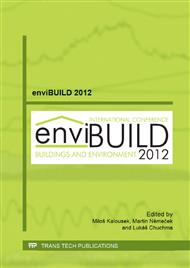[1]
ČSN EN ISO 14044: 2006, Environmentální management – Posuzování životního cyklu – Požadavky a směrnice
Google Scholar
[2]
ČSN ISO/TR 14047: 2004, Environmentální management – Posuzování životního cyklu – Příklady aplikace ISO 14042
Google Scholar
[3]
ČSN EN ISO 14040: 2006, Environmentální management – Posuzování životního cyklu – Požadavky a směrnice
Google Scholar
[4]
ČSN ISO/TR 14049: 2001, Environmentální management – Posuzování životního cyklu – Příklady aplikace ISO/TR 14041 pro stanovení cíle a rozsahu inventarizační analýzy
Google Scholar
[5]
ČSN P ISO TS 14048: 2003, Environmentální management – Posuzování životního cyklu – Formát dokumentace údajů
Google Scholar
[6]
V. Kočí, Posuzování životního cyklu. Life cycle assessment – LCA, first ed., Ekomonitor, Chrudim, (2009)
Google Scholar
[7]
L. Matějka, J. Pěnčík, VUT v Brně, Tepelně izolační kompozitní plast, utility model no. 20388, Praha, (2009)
Google Scholar
[8]
L. Matějka, J. Pěnčík, J. Kučera, VUT v Brně, Koextruzní penetrační linka pro výrobu vysoce plněných kompozitních desek, utility model no. 22361, Praha (2011)
Google Scholar
[9]
C. Fischer, M. Werge, Europe as a Recycling Society - Present recycling levels of Municipal Waste and Construction & Demolition Waste in the EU, European Topic Centre on Sustainable Consumption and Production, Copenhagen, (2009)
Google Scholar
[10]
Z. Stránská, Hodnocení přírodních a recyklovaných surovin a materiálů v budovách. Pojednání k disertační práci. VUT v Brně, Fakulta stavební, 2012, p.19
Google Scholar
[11]
J. Pěnčík, L. Matějka, A. Kalužová, L. Matějka, D. Dostálová, T. Pospíšil, Development of thermal insulation composite material from recycled polymer and recycled glass, Advanced Materials Research 487, 2012, pp.701-705
DOI: 10.4028/www.scientific.net/amr.487.701
Google Scholar
[12]
A. Kalužová, Development of thermally insulating material from secondary raw materials [presentation], VUT v Brně, Fakulta stavební, 2012, p.3
Google Scholar
[13]
V. Dolejší, Posouzení environmentálních dopadů mytí nádobí v automatické myčce a konvenčním způsobem pomocí metody LCA, Diplomová práce VŠCHT, Praha, 2010, p.93
Google Scholar
[14]
P. Hájek, Udržitelná výstavba budov a její uplatňování ve střední Evropě. Časopis Stavebnictví, 2007. Accessible at www.casopisstavebnictvi.cz/clanek.php?detail=465
Google Scholar


